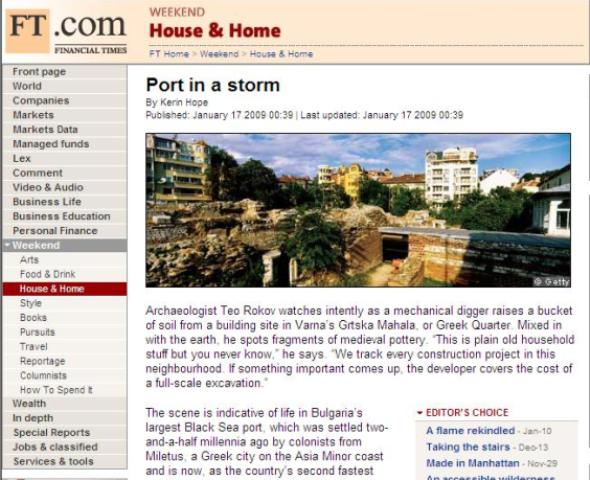Port in a Storm
 Archaeologist Teo Rokov watches intently as a mechanical digger raises a bucket of soil from a building site in Varna’s Grtska Mahala, or Greek Quarter. Mixed in with the earth, he spots fragments of medieval pottery. “This is plain old household stuff but you never know,” he says. “We track every construction project in this neighbourhood. If something important comes up, the developer covers the cost of a full-scale excavation.”
Archaeologist Teo Rokov watches intently as a mechanical digger raises a bucket of soil from a building site in Varna’s Grtska Mahala, or Greek Quarter. Mixed in with the earth, he spots fragments of medieval pottery. “This is plain old household stuff but you never know,” he says. “We track every construction project in this neighbourhood. If something important comes up, the developer covers the cost of a full-scale excavation.”
The scene is indicative of life in Bulgaria’s largest Black Sea port, which was settled two-and-a-half millennia ago by colonists from Miletus, a Greek city on the Asia Minor coast and is now, as the country’s second fastest growing city, coping with a big influx of new residents.
Originally, and for centuries under Greek, Roman and Turkish rule, Varna was a hub for traders shipping salted fish, grain, furs and gold to the Mediterranean and beyond. By the early 1900s Armenians, Jews and Bulgarians had joined Greek merchants and many took part in a grand urban revival of the city, launched by King Ferdinand. New mansions designed by Italian architects were painted in pastel colours appropriate to a fashionable European resort with a pier, wooden bathing huts and a Sea Garden (a stretch of parkland planted with rare trees under the supervision of a renowned Czech botanist and landscaper).
Communism followed and, after that, a gritty transition period, including shootings of local mobsters in crowded seaside cafés. But, according to residents, a group of ex-Bulgarian marines nicknamed the “Varna Seals” eventually managed to expel members of the Russian, Chechen, Ukrainian and Georgian mafias vying for control of the port and the city’s underground economy. And today “you can stroll around the centre late at night without problems,” says Agap Agapov, a restaurant owner in Grtska Mahala.
Varna now draws about 30,000 new residents a year and it was recently rated Bulgaria’s “best city to live in” for the second year running in a poll carried out by Darik Radio, a private station, and 24 Chasa, a national newspaper. Students from three local universities support a lively bar and music scene and, in summer, the city’s seafront promenade fills up with visitors from the capital, Sofia, western European tourists bussed in from nearby resorts for a day’s sightseeing and increasing numbers of Russians, Ukrainians and Romanians, whose own Black Sea coastlines are less hospitable than Bulgaria’s.
The country has been hit by energy shortages this month following Russia’s cut-off of gas supplies to Europe. But the Bulgarian government has now asked the European Union for €400m to build a link with an alternative Turkish-Greek pipeline and Varna itself plans to consider the possibility of building a liquefied natural gas terminal.
Transport links to the city have already been improving, with gradual upgrades to the highway to Sofia, a five-hour drive away, and more frequent air connections via Bulgaria Air, which runs three flights daily to the capital in winter and four in summer. Fraport, a German company, is now running the city airport under a 35-year concession, investing in a runway refurbishment and expanded terminal facilities, and several international airlines, including low-cost operators, now fly to Varna from European hubs.
A new city master plan, due to be launched this year, will be a 21st-century take on King Ferdinand’s grand scheme. Among other projects, the commercial port will be moved to a new site on an inland lagoon to the west of the city, opening up space for what would become the Black Sea’s largest and best-equipped marina. “The new master plan will allow for a major redevelopment of the port site,” says Delyan Dimitrov, of Address, a Bulgarian estate agency. “There’ll be luxury homes, hotels, restaurants – in effect a whole new neighbourhood within a stone’s throw of the Grtska Mahala.”
For now, the Greek Quarter remains one of the most attractive areas to live, with some of the city’s highest property prices, ranging from €2,200 per sq metre for an apartment in a communist-era four-storey block (the maximum height permitted) to €3,000 per sq metre for one in a renovated mansion or a new building with a view of the sea.
Living spaces tend to be compact, with studios running to 50-60 sq metres including the balcony, and 100-120 sq metre apartments deemed a comfortable size for four-member families. Many dilapidated buildings still await refurbishment but the quarter is beloved both by old-timers, such as Agapov, who serves fresh fish from the ground floor of his family home in a space once occupied by his grandfather’s tailoring workshop, as well as new arrivals, such as diving instructor Iasen Ivanchev, who will soon move into an attic apartment one block from the seafront.
“The neighbourhood is changing; a lot of newcomers to Varna have bought homes here. But I wouldn’t live anywhere else,” Agapov says.
“There’s a real sense of community,” Ivanchev adds. “You can walk everywhere and you wake up in the morning to the sound of seagulls calling.”
But there are downsides to living in the Grtska Mahala, including increased traffic, more street noise than in the suburbs and a shortage of parking spaces, with only a handful of new, high-end buildings having underground garages. “When I was growing up here, we played street games all the time. It wasn’t quite the same for my daughter,” says Darina Ivanova, a colleague of Ivanchev, who moved to the neighbourhood as a child.
As a result, some Varna residents opt for less historic neighbourhoods outside the city. The brand-new suburb of Briz has, for example, sprung up across a wooded hillside 5km north of the centre. It boasts panoramic views of the sea and attractive apartment buildings close to the Sea Garden.
The area has developed so fast that it will be another year before access roads and street lighting are completed. But prices for a top-floor apartment with a sea view have doubled in the past two years to about €1,600-2,200 per sq metre and are expected to rise marginally this year in spite of the global economic crisis. “We expect some homeowners in Briz will want to cash in their profits this year, so there’ll be opportunities to buy on the secondary market,” says Evgeni Zlatev, Varna office manager for estate agency Bulgarian Properties.
Jon White, a British software developer who has created a global property portal, and his Estonian wife, Maarika, moved to Varna from the UK four years ago. Last year, they sold a property in the city centre and moved to a top-floor apartment in Briz, a five-minute walk from the beach. “It’s nice and quiet but we have amenities like a good restaurant across the way and a first-rate supermarket just down the road. You can walk or bicycle into town through the Sea Garden,” he says.
Their neighbour is Boryana Shikova, a Varna native who came back to the city after working as a corporate lawyer in New York and London. She used her savings to buy off-plan in Briz. “It’s turned out [to be] a better investment than I could ever have hoped for,” she says. “I feel privileged to live in a place where I can sit on the balcony at night and the only lights are of the ships in the bay.”
Newly developed suburbs to the south of Varna include Asparuhovo, overlooking a sandy beach that curves east to the wooded cliffs of Cape Galata. Once a dormitory district for workers at the city shipyard complete with Soviet-style tower blocks and the site of undeveloped military property, it is now rapidly moving upmarket.
Vladimir Berov, a builder who works on short-term contracts in France and Holland, and his wife, Dobromira, are among the area’s newest residents, having bought an apartment ready for renovation in a block close to the municipality’s seaside park. “We moved here because we thought it a good place to live and it’s going to get better,” Berov says.
Just south of Asparuhovo, local developer Bord has launched a three-building luxury complex called Varna South Bay that is designed for full-time residents – although second-home buyers are likely to be interested too. Yuri Pavlov, a Bord executive, says the aim is to create a dynamic community with easy access to schools and the city via public transport. The 830 apartments range from large studios to duplex penthouses, all with terraces, and prices range from €1,700-€2,500 per sq metre. There will be swimming pools, shops and mini-markets, a 1,000 sq metre fitness centre, a medical facility and underground parking, with a marina and ferry service planned for the development’s second phase.
“We expect that most buyers will be foreigners but some will certainly rent to Bulgarians,” Pavlov says.
Read more about Varna and the real estate market
Read the article in the Financial Times
read more articles
